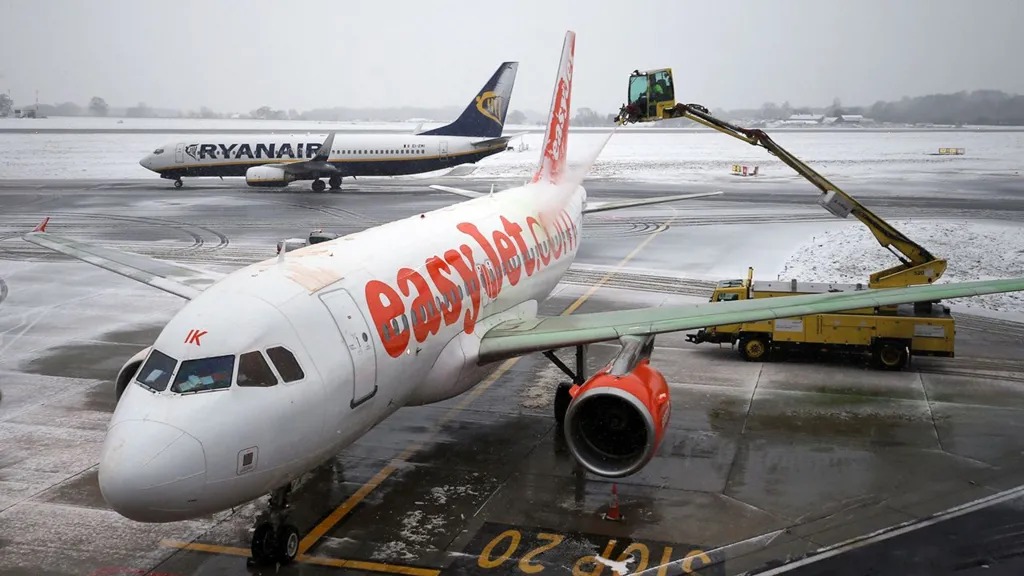
The Impact of Bad Weather on Flights
Why Weather Disrupts Flights
Air travel relies on precision, and even minor weather issues can cause widespread delays:
- Fog and Visibility Issues: Aircraft can land in fog, but safety protocols require increased spacing between planes, reducing airport capacity.
- High Winds: Controllers impose stricter spacing requirements to ensure safe landings.
- Snow and Ice: Clearing runways and maintaining safety adds significant delays.
Real-Life Example: The Christmas Fog
In December 2024, fog disrupted thousands of flights, leaving passengers stranded for hours. Gatwick and Heathrow, two of the busiest airports, struggled to maintain schedules as visibility dropped.
Why Britain Struggles More Than Other Countries
Infrastructure and Climate Preparedness
Unlike countries accustomed to extreme weather, Britain’s historically mild climate has shaped its infrastructure:
- Limited Snow-Handling Capacity: Investments in snow-clearing equipment and training remain insufficient compared to Iceland or Greenland.
- Reactive Planning: British airports often respond to weather issues rather than anticipating them proactively.
Insights from Experts
Travel expert Simon Calder notes that Britain’s airport schedules operate with minimal error margins. A 50% increase in spacing requirements for planes can reduce capacity by one-third, leading to inevitable cancellations.
The Role of Air Traffic Control
NATS and Managing the Skies
The National Air Traffic Service (NATS) plays a crucial role during adverse weather:
- Route Adjustments: Pilots may need to deviate from flight paths to avoid storms, requiring NATS to coordinate new routes and prevent overcrowding in airspace.
- Capacity Limits: NATS imposes restrictions to ensure safety, but this can lead to cascading delays.
Preventative Measures:
NATS uses advanced Met Office weather tools to anticipate disruptions, though these measures cannot eliminate delays entirely.
Climate Change and Future Challenges
Rising Weather Risks
Climate expert Dr. Ella Gilbert warns that climate change is likely to increase the frequency and severity of extreme weather:
- Stronger Storms: Heavier rain, snow, and high winds are expected to disrupt flights more frequently.
- Increased Turbulence: Changes in atmospheric conditions may lead to bumpier flights and more route adjustments.
Passengers’ Rights During Disruptions
What to Do When Flights Are Delayed or Cancelled
Under UK and EU regulations, passengers are entitled to certain protections:
- Meals and Accommodation: Airlines must provide essentials if delays occur.
- Refunds or Rebooking: Travelers can opt for a refund or a replacement flight at no additional cost.
- Compensation Rules: Airlines are not obligated to pay compensation for delays caused by weather, as these are considered beyond their control.
Real Passenger Experience
James and Madison King experienced a diversion and incurred extra expenses during the Christmas fog delays. However, their claim for reimbursement remains unresolved, highlighting the complexities of passenger rights during weather-related disruptions.
Conclusion
Navigating Flight Chaos in Bad Weather
Flight disruptions caused by Britain’s bad weather are a product of safety measures, infrastructure challenges, and unpredictable climate conditions. As extreme weather events become more frequent, both airports and passengers will need to adapt to an increasingly turbulent future.
External and Internal Links
- External Link: Learn more about managing flight delays and cancellations
- Internal Link: Explore travel tips for adverse weather conditions



